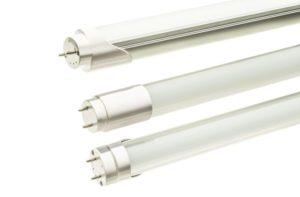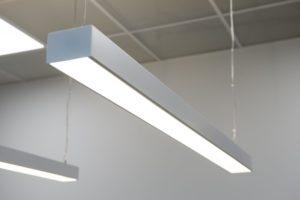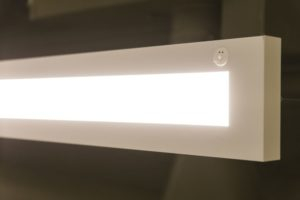Which Lighting System is Right for You?
LED lighting systems are changing the way we light our indoor and outdoor spaces. LEDs offer significant energy savings and dramatically reduce maintenance costs by lasting two to five times longer than fluorescent and HID bulbs. When LEDs include customizable smart controls, you can save substantially more energy and the lighting can be adjusted to meet your needs. Use the chart below to determine which lighting system best fits your needs.
 New retrofit LED lamp without controls
New retrofit LED lamp without controls
|
 New LED fixture or retrofit kit without controls
New LED fixture or retrofit kit without controls
|
 New LED fixture or retrofit kit with integrated controls
New LED fixture or retrofit kit with integrated controls
|
Comfort |
|||
Quality of light  |
Good | Better | Best |
Smart capabilities  |
On/Off | On/Off | On/Off, Dim, Occupancy, Daylight, Color Tuning |
Life  |
 varies by lamp type varies by lamp type
|
 |
 |
Incentives and Savings |
|||
| Utility incentives (contact your utility for more information) | May be limited or lower than new fixture | Calculated or deemed | Calculated |
| Energy Savings | Good | Better | Best |
| Total cost of ownership | Good | Better | Best |
Cost |
|||
| Equipment cost |
 varies by lamp type varies by lamp type
|
 |
 |
| Installation Cost |
 |
 |
 |
| Maintenance Cost |
 varies by lamp type varies by lamp type
|
 |
 |
There are many important factors to consider before beginning your lighting upgrade. Your results will vary based on location, facility layout and electricity costs, among other things.
If you’re not ready for LEDs, ask your lamp supplier about reduced wattage fluorescent lamps. They use far less energy than standard fluorescent lamps at comparable cost, quality and light levels.
New LED lamp
Tubular LEDs (TLEDs), pin-based compact fluorescent-replacement LEDs (CFL-LEDs) high intensity discharge LEDs (HID-LEDs) and screw-based LEDs are replacement lamps for existing fluorescent, HID or incandescent light fixtures. All of these retrofit lamps either use the existing lamp sockets or are otherwise attached to the existing fixture housing. LED replacement lamps typically offer significantly better efficiency and longer life than fluorescent, HID or incandescent lamps. Retrofit kits and new fixtures offer higher energy savings and better lighting quality than lamp replacements.
Types of LEDs available to replace linear fluorescent lamps:
Plug and Play (Type A): Also known as in-line ballast LEDs, these lamps use the existing electronic ballast (if compatible) and sockets. As such, installation does not require rewiring or an electrician. Plug and play TLEDs are typically the fastest and least expensive way to upgrade to TLEDs, but are also the least efficient retrofit option. They can be a short-lived solution due to ballast failure, ballast incompatibility or difficulty in finding a ballast replacement. If dimming is desired a compatible dimming ballast and dimmable LED lamp is required.
Line Voltage (Type B): Also known as ballast bypass, these replacements do not use the existing ballast, eliminating the ballast issues seen in plug and play lamps. They offer greater energy savings than plug and play. Installation costs are higher than plug and play LEDs, as an electrician is required to remove the old ballasts and re-wire the fixture. To add or maintain dimming, the TLED must be dimmable and a new dimmer compatible with the TLED will need to be installed.
External Driver (Type C): Type C lamps use an installation similar to the existing fluorescent lamps except the ballast is replaced with a LED driver. Installation costs are higher than plug and play LEDs, as an electrician is required to replace the old ballasts with a new LED driver. Dimmable versions are available, but will require a compatible dimmer control.
Type A/B: Some TLEDs are designed to be a plug and play Type A lamp when first installed and when the ballast fails can operate as a Type B lamp. If the ballast fails the lamp will not operate unless the ballast is bypassed.
All LED replacement lamps are less efficient than a retrofit kit or new fixture because the light distribution is not optimized for the fixture.
As with all lamp retrofits, testing a solution with a handful of fixtures before applying the upgrade widely is recommended.
New LED Fixture or retrofit kit
New LED fixtures and retrofit kits use LEDs as the light source instead of traditional fluorescent, incandescent or high intensity discharge (HID) sources. The LEDs are factory installed directly to the fixture without the use of traditional lamp sockets. Since fixtures and retrofit kits come with new drivers, they are typically compatible with dimming controls and networked control systems.
New fixtures typically offer higher energy savings, are longer lasting and have the lowest failure potential, compared with retrofit kits or lamp replacements.
A retrofit kit is a bundled set of hardware designed to replace all electrical and lens components of an existing fixture while leaving the original fixture housing in place. A retrofit kit effectively creates a completely new luminaire, without having to replace the entire fixture, typically resulting in lower equipment and installation costs compared to a new fixture. Retrofit kits typically outperform LED replacement lamps installed in existing fixtures, offering longer life, better heat management, lower failure potential and higher efficiency.
New LED fixtures and retrofit kits do not use socket-mounted or magnetically attached LED tubes.
New LED fixture or retrofit kit with integrated controls
Integrated control fixtures and retrofit kits are generally referred to as Luminaire Level Lighting Control (LLLC) fixtures and kits. At minimum, LLLCs incorporate embedded occupancy sensors, daylight sensors and wireless controls into LED light fixtures or retrofit kits. Most LLLC products offer additional energy and occupant comfort features such as continuous dimming, task tuning (brightening or dimming each fixture or a group of fixtures to provide the ideal light level for occupants), programmable scheduling, and more. The fixtures wirelessly communicate with each other, so can operate in groups or independently.
These systems provide maximum energy savings and fixture life, easy installation, and operational efficiencies. While simple payback may take longer, cost of ownership can be significantly lower on these installations, especially when factoring in maintenance savings and ease of reconfiguration.
Quality of light
From the color of the LED light to the lighting distribution of the fixture, retrofitting to LED can improve the quality of lighting in your space compared with traditional technologies. LED lighting tends to show colors more accurately and vibrantly than fluorescent or HID, improving the look of the space.
LED fixtures and retrofit kits can also light the space more effectively. The fixture manufacturer can shape the lighting distribution of the fixture (how the light comes out of the fixture) to optimize the lighting in your space. The optimization could be to get more light on the walls, which will brighten the look of the space, or in a higher ceiling space, to increase the lighting intensity by pushing more light to the floor.
One major benefit of new fixtures is that they don’t have to be put in the same locations as the existing lights. Reconfiguring the lighting in the space allows for adding more light to areas that are under lighted or removing lights (or intensity) to over lighted areas.
Smart capabilities
When paired with sensors and controls, LEDs can offer a range of "smart" capabilities. These features and functions can improve the lighting quality, enhance the occupant experience, decrease operation costs, help your new system meet building code, improve occupant performance and safety, and even help your business run more efficiently. A few of the more common "smart" capabilities include:
- Dimming: vary the light output of the fixture, enabling energy savings and greater occupant satisfaction.
- Occupancy or vacancy control: regulate lighting based on presence or absence of people in a space, enabling energy savings and reduced maintenance costs.
- Daylight control: regulate the light level in response to changing daylight conditions in the space, enabling energy savings.
- Task tuning: adjust the output of individual lights or group of lights to a set lower maximum level, enabling energy savings, greater occupant satisfaction, and lower maintenance costs thanks to longer system life.
- Networking: connect all fixtures as a network, allowing them to exchange information with each other and with an Energy or Building Management Systems (EMS or BMS). Networked fixtures can be configured and controlled individually or as a group; some allow for remote configuration and control. Networking enables reduced wiring, maintenance and reconfiguration costs and greater energy savings.
- Zoning: ability to configure groups of fixtures to perform the same lighting strategies (same occupancy time-outs, same task tuning, etc.). Zoning often results in reduced cost of wiring, maintenance and reconfiguration and greater energy savings.
- Color tuning (only available with color-tunable LEDs): ability to adjust the color temperature of the lamp, enabling higher occupant satisfaction and performance.
- Automation and tracking: Sensors embedded in light fixtures can be used to perform a wide range of functions, from identifying unused meeting rooms, to automating door operation, to track products in a warehouse, enabling improved space utilization and business efficiency.
Utilities often offer enhanced incentives lighting systems that include controls. Contact your local utility to learn about lighting controls incentives available in your area.
Life
LEDs offer significantly longer life compared with incandescent, fluorescent and HID technologies, resulting in much less frequent replacement and lower maintenance costs. For Type A plug and play LED lamps that utilize an existing ballast, the ballast may fail before the LED lamp which will require the ballast to be replaced. Unfortunately, there is no visible indicator that the ballast failed and the only way to test is to install the existing LED lamp in a fixture that is operating properly.
LED life ratings are based on the age at which the fixture or lamp will produce 70% of the light produced compared with its original light output. This is shown on manufacturers’ specification sheets as the L70 designation. Some manufacturers are listing L90, which is the life when the fixture is still producing 90% of its initial light output. Look for an L70 of at least 70,000 hours or L90 of 50,000 hours.
Factors to Consider when Embarking on a Lighting Upgrade
There are a range of factors to consider when retrofitting an existing fixture. The following are important considerations that could influence your decision:
- Age and condition of ballast: When retrofitting an existing fixture with direct replacement LED lamps, consider the type and age of the existing ballast when replacing fluorescent or pin-based compact fluorescent. Failure of older existing ballasts before TLED end-of-life will defeat the ‘reduced maintenance’ attractiveness of TLED. Some incentive programs restrict use of existing ballasts, especially T12 ballasts, in lighting upgrades.
- Age and condition of sockets: As fixtures age, lamp sockets can become brittle due to the heat and UV exposure they experience over time. Older fixtures may need new sockets to offer best life expectancy.
- Net Efficacy: New highly-efficient LED products installed into existing fixtures can experience losses of up to 10 – 15% due to inter-reflected light loss – basically, light trapped within the fixture. Addition of a lens will reduce efficiency another 10 – 12%, or even more if the lens is old and yellowed. Note that these reductions were present with the existing fluorescent lamps also.
- Light Distribution: The way a fixture distributes light is determined by its reflectors and lens, which are designed around the original lamp type. Replacing existing lamps with LEDs will change the distribution characteristics of the fixture, which may cause shadowing or sharp cutoff at walls. A test installation will help determine whether direct one-for-one lamp replacement will give suitable results. Be sure to evaluate the light levels, the lighting distribution and the visual look of the space in the test installation.
-
Labor costs: Labor costs will depend on the type of LED retrofit planned.
- LED lamps – LED lamp replacement can be as simple as removing the fluorescent lamps and plugging in an LED lamp. LED lamps may require incompatible ballasts to be replaced, may require removal of the existing ballast and rewiring of the fixture, or may require replacement of the ballast with a new LED driver. In all cases damaged sockets should be replaced.
- Retrofit kits – install into the existing housing from below the ceiling and can be an effective alternative to LED lamps or new fixtures. They generally require removal of all internal components of the existing fixture and installation of new internal LED components.
- New Fixtures – replace the entire existing fixture. With new fixtures the replacements do not need to be on a one-for-one basis or even in the same location which allows for lighting to be optimized in the space. Replacing or relocating a fixture may require seismic anchor wires (slack wires), which may or may not be present on the existing fixtures.
Some types of replacements require an electrician. The new fixture, retrofit kit and replacement lamp descriptions in this guide provide additional details regarding which types of retrofits will require an electrician.
Links to a PDF copy and customizable InDesign files for the Lighting Comparison Tool are below.
